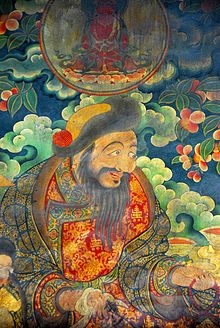Gushri Khan

Gushri Khan (Töröbaikhu Nomin, * 1582 , † 1655 ), a prince of the West Mongolian, Oirat Choschuts , helped the fifth Dalai Lama Ngawang Lobsang Gyatsho (1617–1682) to political power over Tibet and became the first Khan of the Choschuten Khanate .
The plight of the Gelugpa
The Dalai Lama's Gelugpa sect had little support in Tibet around 1635. The 10th Karmapa and the governor or regent of Tsang in central Tibet had allied against them, the Mongols under Chogtu († 1637, one of the subordinates of the late Ligdan Khan ) and the prince of Beri in eastern Tibet (a Bonpo ) joined them. Mongolian troops repeatedly invaded Tibet and got as far as Drepung . In an emergency, the Gelugpa then accepted the Oirats' help against their enemies, especially that of Khungtaidschi Batur (ruled 1634–1653, from the Jüün Ghar ) and Gushri Khan from the Khoshuud.
The struggle for Tibet
The Choschuten , a subgroup of the Oirats nomadized under Gushri Khan in Amdo (= Qinghai), especially in the area around the Kokonor and Tsaidam .
Gushri is mentioned as early as 1630 when he defeated a renegade Oiraten prince on the Ural River together with Dalay, the prince of the Dürbeten (a third subgroup of the Oirats) Chokur . With the political successes of their prince, the Khoshuud took control of the Tibetan nomads as far as eastern Jangthang, northern Kham and southern Amdo. So Gushri Khan defeated the Chogtu Mongols in 1637, in 1638 he was appointed king of Tibet, in 1639 he marched against Beri and in 1641 he stormed the fortress of Samzhubzê , captured the ruler of Tsang (the "Tsangpa Desi") and executed him. After this seven-year war, all opponents of the Gelugpa were eliminated and the Khan transferred political power over the country to the fifth Dalai Lama (1642).
As a result, Tibet was administered through an established by the fifth Dalai Lama Desi (ie regent), and the Mongolian Khan in age-proven way, the Desi the role of spiritual teacher and Khan the role of gifts men occupied. A picture in the courtyard of the Jokhang Temple attests to this.
His successor
Gushri Khan's successor was his son Dayan Otschir Khan (r. 1656–1668), then his son Dalai Khan and finally Latsang Khan (r. 1700 / 1–1717), under whom the power of the Choschut over Tibet came to an end.
literature
- Christopher P. Atwood: Encyclopedia of Mongolia and the Mongol Empire. Facts on File, New York 2004, ISBN 978-0-8160-4671-3 .
Web links
- Samten C. Karmay (2005): The Great Fifth . (PDF, 181 kB) Retrieved December 16, 2007.
| personal data | |
|---|---|
| SURNAME | Gushri Khan |
| ALTERNATIVE NAMES | Töröbaikhu Nomin; Gushi Han (pinyin); bsTan 'dzin chos rgyal |
| BRIEF DESCRIPTION | Prince of the Western Mongolian Khoshuud |
| DATE OF BIRTH | 1582 |
| DATE OF DEATH | 1655 |